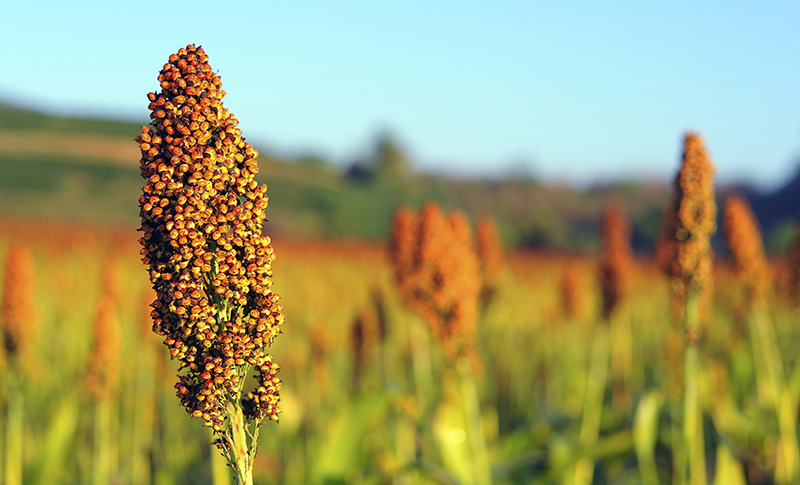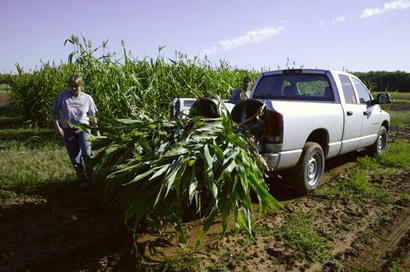Sorghum

Grain Sorghum
- Sorghum is a coarse, upright growing grass that is used for both grain and forage production. Grain sorghum is shorter and has been bred for higher grain yields.
- Grain sorghum is also called "milo" and is a major feed grain for cattle.
- Grain sorghum grows well in Oklahoma because it doesn't require a lot of water and can survive long, hot summers.
- In Oklahoma and throughout the US, sorghum is a principal feed ingredient for both cattle and poultry. Its protein content is higher than corn and about equal to wheat. Its fat content is lower than corn but higher than wheat.
- Sorghum has a very hard kernel, which makes it resistant to disease and damage but harder to digest for animals.
- Sorghum is ground, cracked, steam flaked, and/or roasted. It can be cooked like rice, made into porridge, malted for beer, baked into flatbreads and popped like popcorn.
- Sorghum originated in Egypt 4,000 years ago and today is Africa's second most important cereal. Africa now produces 20 million tons of sorghum per year, a third of the world total.
- From Egypt, sorghum spread throughout Africa and into India. It is one of the longest-cultivated plants of warm regions in Africa and Asia–especially in India and China.
- Sorghum has now become an important crop in Latin America as well. The crop has gained prominence in Mexico over the past half-century, and the number of hectares of sorghum planted in the country grew over 1,000 percent from 1958 to 1980. Mexico has large areas of dry farmland, and sorghum requires less water than maize and wheat.
- The first sorghum seeds may have been brought into the United States during the late 1700's on slave ships. At that time it was known as "Guinea corn."
- It is believed that Benjamin Franklin introduced the first grain sorghum crop to the United States.
- Sorghum ranks fifth among the most important cereal crops of the world, after wheat, rice, maize, and barley in both total area planted and production.
- Eighty percent of the area devoted to sorghum is located within Africa and Asia.
- Grain sorghum plants are coarse annual grasses. Nearly all varieties grown in the United States are dwarf types, with stems under 5 feet in height and suitable for harvesting with combines. Many taller-stemmed varieties are grown in other countries.
- Like corn, sorghum can be grown under a wide range of soil and climatic conditions. Unlike corn, however, sorghum's yield under different conditions is not so varied. Consequently, it is grown primarily in arid areas where corn wouldn't make it without substantial irrigation.
- In Africa, the straw of traditional tall sorghums is used to make palisades in villages or around a homestead. The plant bases are an important source of fuel for cooking and the stems of wild varieties are used to make baskets or fish traps. Dye extracted from sorghum is used in West Africa to color leather red.
- Sorghum starch is manufactured in the US by a wet-milling process similar to that used for corn starch, then made into dextrose for use in foods.
- Starch from waxy sorghums is used in adhesives and for sizing paper and fabrics, and is an ingredient in oil drilling "mud."
- Oklahoma is one of the top seven states where grain sorghum is produced. An average of 15 million bushels are harvested for grain each year. The majority of grain sorghum is produced in the panhandle and north-central Oklahoma, however, it is also grown in the northeast and southwestern areas of the state. Grain sorghum is primarily used as cattle or hog feed either in Oklahoma or shipped out-of-state to other livestock producers.
- Durra, feterita, kaffir or kaffir corn, kaoliang, milo or milo maize, and shallu are all varieties of grain sorghum. The pulverized grain is used for stock and poultry feeds and, in the Old World, for food. Sorghums also provide cover crops and green manures, grain substitutes for many industrial processes that employ corn, and fuel and weaving material from the stems. Other classes of sorghums include sweet sorghums and broom corn.
- In the United States, sorghum is grown throughout the Great Plains area and in Arizona and California; about half the crop is used for forage and silage and half for feed grains. Only a small amount is grown for syrup,
- Johnsongrass is a variety of sorghum native to Africa that has become an invasive weed in Oklahoma.
Sweet Sorghum
- Sorghum is an important part of the diets of many people in the world. It is made into unleavened breads, boiled porridge or gruel, malted beverages, and specialty foods such as popped grain and syrup from sweet sorghum.
- Sweet sorghum has been widely cultivated in the U.S. since the 1850s for use in sweeteners, primarily in the form of sorghum syrup.
- By the early 1900s, the U.S. produced 20 million gallons of sweet sorghum syrup annually.
- Making syrup from sorghum (as from sugar cane) is heavily labor intensive. Following World War II, with the declining availability of farm labor, sorghum syrup production fell drastically. Currently, less than 1 million gallons are produced annually in the U.S.
- Most sorghum grown for syrup production is grown in Alabama, Arkansas, Georgia, Iowa, Kentucky, Mississippi, North Carolina, and Tennessee.
- Sorghum syrup and hot biscuits are a traditional breakfast in southern Appalachia.
- Sweet sorghum syrup is called "molasses" or "sorghum molasses" in some regions of the U.S., but the term molasses more properly refers to a different sweet syrup, made as a byproduct of sugarcane or sugar beet production.
- Wewoka holds a sorghum festival in October.
- Many years ago sorghum was the sweetener of choice because sugar was too expensive.
- Sweet sorghum is made from 100 percent pure, natural juice extracted from sorghum cane. The juice is cleansed of impurities and concentrated by evaporation in open pans into a clear, amber colored, mild flavored syrup. The syrup retains all of its natural sugars and other nutrients.
- The syrup was an important sweetener for many small communities well into this century and even today is still locally important. In the 1860s sorghum cultivation was concentrated in the Midwest, but by the 1890s it had become predominately a southern crop. Production reached a peak of 24 million gallons in the 1880s and then declined over the next century in the face of competition from glucose syrups.
- Sorghum contains iron, calcium and potassium. Before the invention of daily vitamins, many doctors prescribed sorghum as a daily supplement for people with deficiencies in these nutrients.
- Sweet sorghum can be grown throughout temperate climate zones of the United States, including Oklahoma.
- Sorghum produces the same amount of ethanol per bushel as corn. Currently, 12 percent of sorghum production in the US is used to make ethanol.
- OSU is conducting research on sorghum as a possible source of ethanol. It provides high biomass yield with much lower irrigation and fertilizer requirements for corn. Research is focused on processing sweet sorghum in the farmer's field to save transportation costs and the cost of building and maintaining central processing facilities.
 Members of the OSU Biofuels Team harvest sweet sorghum to test the feasibility of in-field processing.
Members of the OSU Biofuels Team harvest sweet sorghum to test the feasibility of in-field processing.Photo by Todd Johnson, OSU
